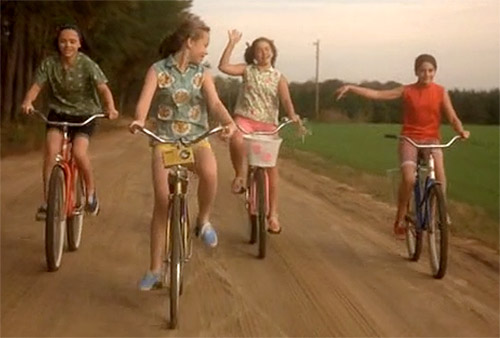Cruisin’ in the USA

I remember it like it was yesterday. I had never experienced such a sense of pure, ecstatic joy up until my 12th year of life when I received what would be a life changing gift: my first bike. As my hands shook, I did my best to delicately remove the red ribbon my mother had attached to the handlebars. I could barely see what I was doing through the tears welling up in my eyes. Having asked for nothing else for three whole Christmases, birthdays and heck, even national holidays (Labor Day sales always had the best selection), this light pink Schwinn Talula cruiser before me was the stuff of dreams. Complete with a basket and bell, I could not wait to take it out and ride it into the sunset. Or, how it turns out, ride it around the block a couple of times before I had to change for church.
Your first bike is a rite of passage. The possibilities and freedom that it allotted you as a young adolescent to explore the neighborhood and meet new friends; the independence it bestowed as you rode it to school. These are still the same sensations and attributes that cycling continues to provide even as adults.
Pedalin’ Prowess
In recent times, there has been a steady boom in the integration of cycling back into our daily lives. The boom is largely responsible for the new onslaught of bike sharing programs, commuting options and the reemergence certain sports, such as triathlon, to keep cycling in the mainstream. It is the flexibility and accessibility of these features, coupled with its environmentally friendly consumption and health benefits to its users that it continues to claim and revolutionize our cities today. In just Chicago alone, there are “200-plus miles of bike lanes and 13,000 bike racks…(With a plan to have) a total of 645 miles of lanes by 2020.” Below we look at some of the newcomers to the bike scene, the benefits to cycling and the importance of sharing the road.
Goin’ Green and Fightin’ Fit
The health benefits to cycling are numerous. The calorie burning from just an hour of riding a bike can be anywhere from 500 – 650 calories. It is great cross training for new swimmers as the intensity and range helps build your lounges and air intake. Riding a bike works on multiple muscle groups from your quadriceps to your calf muscles; helping to keep you on point, in one swift pedal, with leg day. The beauty of biking comes from your environment. We often get lost in our heads when running or lifting weights but biking keeps you present and keeps you energized as it allows you to take on challenges as they come: hills, crowded pathways, the open road. As we mentioned earlier, it helps with cross training from other sports such as swimming and running as it eases up the exertion placed on your arms and feet.
In cities like Miami, where public transportation is more of a hassle than a benefit, new bike lanes in the downtown area and public parks have allowed for a cleaner, more affordable option to get around. According to the National Household Travel Survey, “Americans older than 25 accounted for most of the increase in cycling…” Millennials seem to be the driving force behind the sustainability and fitness efforts behind the recent surge.”We are more aware of the pollution crisis and the affect our negligence will have on future generations. We are living through stronger storms and more volatile weather all due to global warming. If there is anything to be done, it needs to start now.” states Chelsea Walsh of Biscayne Bay. In an effort to combat our ever increasing air pollutants, many jobs have offered stipends or perks to those employees who commute to work. In addition, these new lanes and special parks are being built in once abandoned and derelict areas of the city that will be transformed with beautification projects that include gardens and compost areas.
Learning to Share the Road
While there has been a reemergence in the pastime, there are still dangers to contend with when out on the road. When bike sharing first emerged, there was a major outcry against programs such as Divvy and Citi bikes as many stated that it would flood the already brimming crowds of bustling cities.. Having to be aware of tourist pedestrian traffic while in your vehicle is one thing, but adding speed and inertia has led to countless accidents and hospitalizations. Whether the error lies on the cyclist or the vehicle varies in each situation but for the most part the fault is two-fold. Ride sharing benefits the city as an extension of tourism but riders are novices to the layout and without proper protection. They are more focused on finding where they’re going than to their immediate surroundings. At the same time, there are more experienced bikers who neglect the rules of the road and will swirl past traffic and stop lights to beat traffic.
Many vehicle drivers forget to share the road and will make lane changes or turns without being cognizant of our bikers. I know I’ve been the recipient of foul and imaginative slew of words when cutting off a fellow cyclist. Bike lane improvements have been proposed in many cities to add items such as buffers, plants and cement partitions to further protect both entities on the road. The latest study, published as a research letter Sept. 1 in JAMA, documents “a rise in cycling-related injuries and hospitalizations among adults from 1998 to 2013. Adjusted for age, reported injuries rose 28 percent, and resulting hospitalizations increased 120 percent. There was also an increase, to 56 percent from 40 percent, of accidents that occurred on streets.”
Safety First
Education plays a vital role if we want to make any progress in fully and efficiently integrating cycling into our daily lives. While the idea of buying a car without seat belts is bizarre, slow progress has been made in properly educating newcomers to keeping safe. Yasamin Sabeti, a local Chicago resident brings up a good point: “One of the things that scares me the most is seeing so many cyclists without helmets. It is the only protection you have between outside negligence and your brain. Not sure why this is still an option and not a requirement.” There are many gadgets out there today to keep you protected and safe; ranging from lights to side mirrors to reflective clothing. The industry is growing with the popularity rise, with many local bike stores seeing a surge in both attendance and sales.
The surge of sports such as triathlon and cycling have also helped to educate the populace by bringing the importance of safety to the forefront. Many events are certified by upper governing bodies such as USA Triathlon, who adhere to strict guidelines when competing in one of their events. Kids will see their favorite celebrities in protective gear and will follow suit. Many schools are hoping to implement videos and programs into their curriculum in an effort to bring light to the severity of negligence in the same manner that drunk driving videos have done to first time drivers.
In essence, there is much innovation coming forth from the cycling world and it is interesting to see how cities and their populace continue to integrate and grow with the surge. Whether you’re an active commuter or a novice unwrapping their first bike with shaking hands, there is no denying the many strides that have been made for our favorite pastime.
See below for links to amazing biking programs in a city near you!
